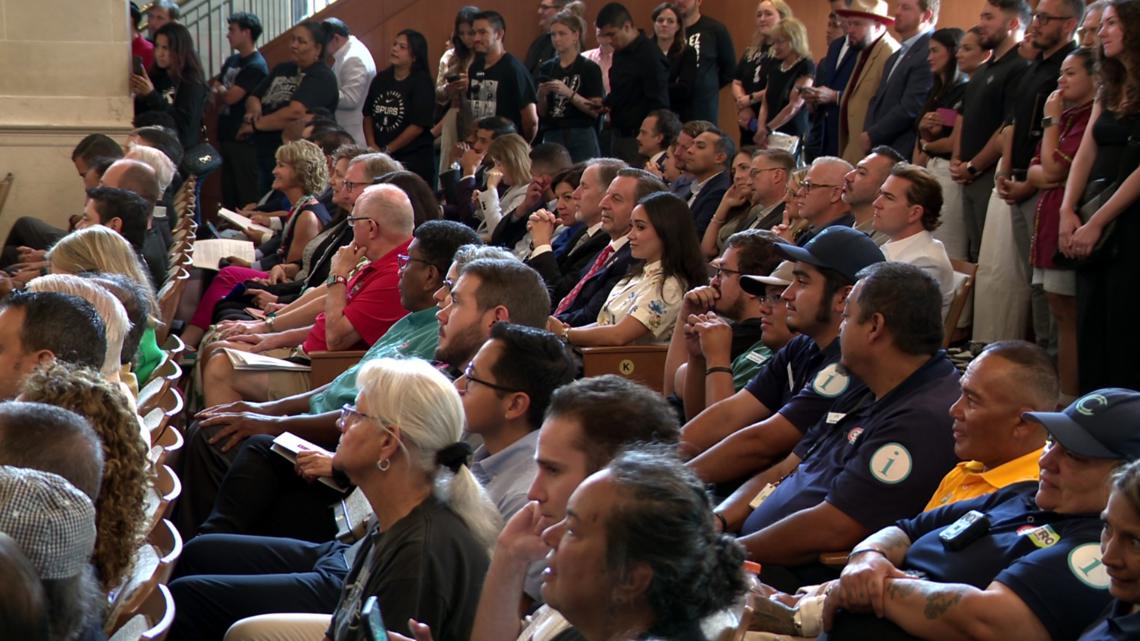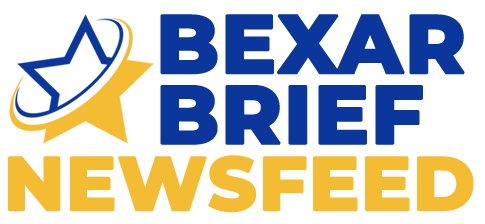
Here’s what we’re seeing at City Hall as council prepares to make a potentially milestone decision.
SAN ANTONIO — The sight of a packed City Hall in downtown San Antonio was a sign of the pivotal discussion to come between city leaders: One that could pave the way for approval of a term sheet between the city and Spurs for a $1.3 billion arena or delay that approval at the behest of Mayor Gina Ortiz Jones, who has called for an independent economic analysis.
In the end — around 3:30 p.m. — city leaders voted to move ahead with the proposed funding framework, marking a significant checkpoint for San Antonio’s Project Marvel ambitions.
The meeting, which featured dueling resolutions that would impact the timeline of Spurs arena development, began at 9 a.m. There were more than three hours of public comment before council began discussion.
Read on for a review of the day’s events at City Council.
3:30 p.m.
City Council voted 7-4 to approve the term sheet between the city and Spurs, giving the green light to City Manager Erik Walsh to proceed with executing it. Mayor Jones, along with Council members Castillo-Anguiano, Castillo and Galvan, were the only ones to vote against as they pushed for an additional, independent economic impact study.
“Today’s vote is an important step forward for San Antonio,” Peter J. Holt, chair of Spurs Sports & Entertainment, said in a statement after the vote. “I want to thank the members of City Council, the City staff and County for their leadership, diligence and collaboration in helping us reach this point.”
3 p.m.
Over the first hour of council discussion on the term sheet, members of the 11-person body began to lay out the reasons why they would be voting for or against the proposed agreement.
Council members Phyllis Viagran, Misty Spears, Marc Whyte and Teri Castillo have indicated they will vote to approve the term sheet, saying Bexar County voters need to know all the funding pieces before the November venue tax election.
“We have an opportunity through this project to do something so good for all of San Antonio—for every citizens in all four corners of this city,” Whyte said, adding there isn’t an economic study out there “that can truly value the San Antonio Spurs’ worth to San Antonio.”
On the flip side, Councilman Leto Castillo-Anguiano — the interim representative for District 2 — asserted that his constituents have told the District 2 office that they don’t see how Project Marvel would benefit them. Councilwoman Teri Castillo said voting to move forward “would be fiscally irresponsible.”
“We are still sitting emptyhanded, under-funded. How is it OK for the city to move on without addressing this?” Castillo-Anguiano said. “The public engagement rollout of this entire project has been fumbled.”
1:55 p.m.
Mayor Jones’ resolution to delay a vote on the term sheet failed in a 4-7 vote, with the mayor, District 2 Interim Councilman Leo Castillo-Anguiano, District 6 Councilman Ric Galvan and District 5 Councilwoman Teri Castillo the only lone aye votes.
Just before the vote, Jones tried to frame the discussion as being “about how this community understands our worth and how we understand who we take into account and how we take things into account when we make significant decisions like this.”
The rejection of the resolution paves the way for approval of the term sheet. Discussion on that is happening now.
1:30 p.m.
After nearly three and a half hours, the public comment portion of Thursday’s meeting has ended. Council is in brief recess before they reconvene at 1:45 p.m. to discuss the mayor’s resolution to a delay a term sheet vote and start on planning an independent economic impact study.
1 p.m.
We’re nearing three hours of public comment at City Hall, a longer-than-usual portion of the meeting which has featured passion on both sides of the debates and comments from major San Antonio figures, including Sean Elliott and the CEOs of the San Antonio Chamber of Commerce and San Antonio Sports.
A majority of speakers so far appear to be in support of the mayor and City Council pausing talks with the Spurs to pursue an independent economic study—a priority of Jones’.
There’s about 10 people still left to speak.
12:35 p.m.
Accompanied by one of the largest groups attending the podium during public comment, Sean Elliott – a former fan-favorite Spurs player who now works as a broadcaster for the team – spoke in support of approving the term sheet. He shared about how he didn’t know about San Antonio upon being drafted in 1994 and has gone on to stay and work in the city for more than 30 years—life developments that, he pointed out, other Spurs legends like Manu Ginobili and David Robinson can attest to.
“The Spurs have always been an instrument for bigger things to build up San Antonio… I can say without hesitation that no other professional sports franchise engages the community like the San Antonio Spurs do,” Elliott said. “We are a city on the rise. This gives us a chance to really soar.”
After, Holt again reiterated how much money the team is pledging to Project Marvel, adding that “this arena will be owned by the public, paid for by tourists and operated by the Spurs.”
10:45 a.m.
San Antonio Sports CEO Jenny Carnes addresses council members during public comment, commending Jones for her “thoroughness” before saying a delay “jeopardizes our relationships with the Spurs” and “delay the momentum we have going.”
Moments later, Valero Alamo Bowl CEO Derrick Fox said a re-energized downtown would continue to keep San Antonio competitive as a major U.S. city that national partners are envious of. Project Marvel is comprised not only of a new Spurs arena, but multiple anchor projects that also include an expanded Henry B. González Convention Center, conversion of the federal courthouse into a live music venue, future renovations to the Alamodome and millions of dollars in new development nearby.
Thus far, public comments shows resolution support is drawn fairly evenly between business leaders and grassroots community advocates or residents.
“I’m shocked at how this process has transpired,” said a man identifying himself as an east-side pastor. “Is this really how San Antonio does politics—in the dark?”
10:35 a.m.
Jeff Webster, head of the San Antonio Chamber of Commerce, urged council members to approve the term sheet, saying the Spurs’ financial pledge amounts to more than the unfulfilled economic promises made to east side residents decades ago, during discussions of the now-Frost Bank Center.
“The difference is, what we’re seeing today – what you saw on those slides presented by the city – talks about commitment,” Webster said. “Mr. Holt, I thank you for offering up not only $500 million for the arena, but the additional money to investment. It’s not build it and they will come; it’s build it and they will build it.”
10:10 a.m.
Public comment begins, with 108 individuals signed up to speak. The first speaker, Graciela Sanchez, director of the Esperanza Peace and Justice Center, called Project Marvel evidence that “Control of the city is still in the hands of the financial elite.”
Two women standing with Sanchez carried signs reading “Our $$$, our decisions” and “Transparency is key.”
“Many of you are business people or consider yourselves caretakers of public funds,” Sanchez told council members. “You surely know a responsible businessperson would require an independent economic analysis.”
9:55 a.m.
City staff reminded San Antonio leaders as well as the public about the terms of the proposed agreement, which is contingent on a scheduled Nov. 4 Bexar County venue tax election. That funding source would provide $311 million for the Spurs arena, to be paid for via hotel and rental car tax.
The city’s contribution of up to $489 million would be covered by the issuance of bonds repaid over time through Spurs lease payments, incremental tax revenue and a Project Finance Zone that allows the city to recoup state dollars for Project Marvel. The team would be on the hook for cost overruns.
The arena funding framework as laid out in the term sheet is contingent on the venue tax measure passing in November. According to the document, it’s estimated it would take 57 months to design and build a downtown arena in the former site of the Institute of Texan Cultures.
9:45 a.m.
Before the public comment portion of Thursday’s meeting began, there was a brief showdown between Jones and Peter J. Holt, the chairman of Spurs Sports & Entertainment.
Technically speaking, Jones initiated council discussion early with a motion and subsequent second in order to ask Holt whether the Spurs would be supporting of the city pursuing an independent impact study on a downtown arena. Holt responded by pointing to what he called a “historic” investment the Spurs have committed to, including $500 million for the arena and a $75 million community benefits investment.
In what took shape almost as a judicial proceeding, Jones twice more asked Holt if the Spurs would support the city conducting another economic analysis. Holt repeated his refrain about the organization’s investment as laid out in the term sheet.
“There’s ample information… this city deserves an urban core that we are proud of, that is unifying, that is accessible and that keeps San Antonio’s progress to be a world-class destination,” Holt said. “We’re willing to invest billions of dollars into that.”
It amounted to a remarkable blinking contest, both sides receiving loud applause from their respective cohorts of supporters.
Jones has spent the last two weeks pressuring fellow members of the 11-person City Council to delay term sheet approval, calling out “significant gaps” in an economic study presented to them on Aug. 6 by CSL International. That firm is owned by a co-owner of the Spurs, which Jones and some council members have called out.
